This is the second of two pieces on the G7’s vision for a clean green plan. Read the first installment here.
While the West’s vision to decarbonize the Global South and fight Chinese influence is promising, it’s nothing like a green version of the Marshall Plan yet. It needs to be.
First outlined at least year’s Group of Seven (G7) summit, it will only reach its full potential if the West’s leaders make it a priority. Covering geopolitics, climate, trade, investment, and aid, it cuts across multiple government departments—and only the leaders have the capacity to break down the bureaucratic silos inside their governments.
For now, it’s unclear whether the West will show unity of purpose in driving forward its vision, which is comprised of American, European, and British plans. This is partly because the leaders are distracted by Ukraine, and because various actors—especially the United States and the European Union (EU)—have very different approaches to climate policy.
This, among other reasons, is why the G7 must be clearer about what it is trying to do. For example, at the moment, US President Joe Biden sometimes sees Build Back Better World (B3W), the American component of the strategy, as a catch-all infrastructure initiative. But it will achieve more if it is sharply focused on helping the Global South with fast and fair transitions to net-zero carbon emissions. These G7 powers also have vastly different approaches to their own climate policies, with the EU and United Kingdom being the most aggressive, which will make it harder to approach the rest of the world with a unified plan.
Having different names—B3W, the EU’s Global Gateway, and the United Kingdom’s Clean Green Initiative (an idea I helped shape in a pitch to British Prime Minister Boris Johnson in March 2021)—doesn’t help either. But the exact name is less important than picking a single one and coordinating more closely under it: The G7 will then be able to sing from the same hymn sheet and motivate all the relevant stakeholders, from politicians and policy makers to financiers and international financial institutions.
The G7 should also think big. The United Kingdom, which has been leading on a deal to decarbonize South Africa and is still president of the 26th United Nations Climate Change Conference of the Parties (COP26) until November, is aiming to push decarbonization plans for a few more countries this year. France has proposed that the EU add five more African countries, including Egypt and Morocco, to the list. And Germany, as this year’s president of the G7, has produced a master list with each G7 country being given responsibility for one or more countries in the Global South. Meanwhile, several large emerging countries, including Indonesia and Vietnam, are interested in partnership deals.
This is a useful start; but to be transformational, the plan needs to cover the bulk of the 130 or so countries that make up the Global South over the next few years.
The G7 also needs to be clear what it is looking for: ambitious 2030 carbon-reduction targets and net-zero dates of around 2050. Some developing countries will argue that this is too much of a stretch, rightly pointing out that because they haven’t caused most of the emissions responsible for climate change, it’s not fair to keep them trapped in poverty.
Yet they all signed up to the COP26 Glasgow Climate Pact, which called for net zero targets of “by or around mid-century” and committed them to revisit and strengthen as necessary their medium-term decarbonization plans.
Developing and emerging countries have much to gain from rapid transitions to net zero. Not only will they avoid the worst ravages of climate change, but hundreds of millions of people will gain access to electricity for the first time; millions of lives will be saved each year from lower levels of air pollution; and their industries will be at the forefront of the next industrial revolution. Finally, switching to clean energy will save them money as oil and gas prices soar.
But funding for this grand collective plan remains an issue.
Turning billions into trillions
The Glasgow Climate Pact emphasized the need to take “different national circumstances” into account—and clearly one of the most relevant circumstances for developing countries is that they lack the resources to hit mid-century net-zero targets. Many were suffering from debt loads even before the COVID-19 pandemic; now, they must cope with the higher food and fuel prices unleashed by the Ukraine crisis.
The G7 leaders say they will scale up climate finance from “billions to trillions” to fund their plan. Experts estimate the Global South will likely need one trillion dollars a year for the rest of this decade to make the switch.
But how can the West mobilize such a large amount of money? This is ten times the one hundred billion dollars per year in climate finance the rich countries promised to mobilize for developing countries by 2020—and still have not delivered. They, too, are loaded up with debt from fighting the pandemic, and their finances will take a further hit as a result of the Ukraine war thanks to increases in defense spending and subsidies to cushion their own consumers from energy price hikes.
Still, if G7 countries think outside the box, they can make relatively small amounts of taxpayer money go a long way. They can tap capital from various sources that don’t hit their budgets—private capital, guarantees, and international financial institutions—and thus turn billions into trillions.
But the lion’s share of the investment must come from the private sector and go to private-sector projects. The plan is a huge opportunity for Western investors, companies, and technologists to drive forward green industrial revolutions around the world by leveraging their entrepreneurial skills.
What’s more, Western banks, insurance companies, and pension funds are under increasing pressure to align their activities with the 2015 Paris Agreement. Large numbers of them have joined the Glasgow Financial Alliance for Net Zero, which accounted for $130 trillion in assets as of last year’s COP26. But little of this money is flowing to emerging and developing economies because the risks (such as bureaucracy, corruption, or political conflicts) are too high.
Developing countries can make themselves more attractive to private investment by cutting bureaucracy and corruption, ending fossil-fuel subsidies, introducing carbon pricing, restructuring bankrupt power utilities, and so forth. Meanwhile, Western governments can absorb some of the remaining risks themselves.
Rich countries have traditionally helped developing countries through grants or cheap loans. But guaranteeing private investments—something the EU and United Kingdom have promised to do—would be a better bet.
Multilateral multipliers
The West can also mobilize the multilateral development banks (MDBs), led by the World Bank, which have huge expertise in dealing with developing countries but haven’t yet been adequately focused on climate change. Nor have they worked sufficiently with the private sector.
Routing funds through them can be extremely cost-effective. They operate on the principle of “callable capital,” meaning their shareholders (the biggest of which are Western governments) put in a small fraction of their capital with the rest supplied only if there are losses. The MDBs can also leverage their capital by borrowing and they, too, can crowd in the private investors to work with them on common projects.
Now, G7 countries need to use their controlling shareholdings in most of the MDBs to give them a new climate-focused mission by devoting more of their resources to green projects. They should also top up the capital of those institutions, showing enthusiasm for the task.
Further sources of funding which don’t hit rich countries’ budgets are the International Monetary Fund’s “special drawing rights” (SDRs). These are something akin to global money-printing: While SDRs aren’t cash, they can be converted into hard currency. Last year, the IMF issued $650 billion in SDRs to its members in response to the pandemic. This followed the issue of $250 billion during the global financial crisis.
The snag here is that most SDRs have gone to rich countries that don’t need them, because the amounts are based on a country’s contribution to the IMF. That’s why the organization is working on a plan to channel $45 billion of the rich countries’ excess SDRs into a trust to help countries build resilience to climate change, among other shocks. But this is not nearly ambitious enough: The West should think ten times that number. After all, rich countries already have about $500 billion in SDRs that they don’t need.
Critics might say there is no magic money tree. Even though guarantees, callable capital, and SDRs don’t hit government budgets immediately, they could do so in the future; these are so-called “off-balance-sheet liabilities.” While that’s true, they pale in comparison to the off-balance-sheet liabilities that the West is running by not tackling climate change decisively—and by reacting too late to the threat from China.
The West has the basis of a clean green plan which not only helps save the planet but also has huge geostrategic benefits. But it will only achieve its potential if it shows ambition and unity of purpose while nailing down exactly where the money will come from.
Hugo Dixon is a journalist, campaigner and entrepreneur. A version of this article was published by RUSI.
Further reading
Fri, Apr 22, 2022
How Putin made the case for the G7’s clean green plan
New Atlanticist By
To counter China and decarbonize the Global South, the West must drive its plan forward with ambition.
Wed, Nov 3, 2021
Can innovation save the planet?
New Atlanticist By Dan Peleschuk
Policy heavyweights Bill Gates and John Kerry and experts from the UAE and Kenya joined the Atlantic Council at COP26 in Glasgow, Scotland, to discuss the technological breakthroughs that can make a lasting impact on climate change.
Thu, Oct 14, 2021
For Africa to go green, the private sector must step up. Could COP26 provide an answer?
AfricaSource By
The continent possesses an abundance of renewable-energy-production capabilities—but capitalizing on its potential remains a challenge.
Image: A thermosolar power plant is pictured at Noor II Ouarzazate, Morocco, November 4, 2016. Picture taken November 4, 2016. REUTERS/Youssef Boudlal




